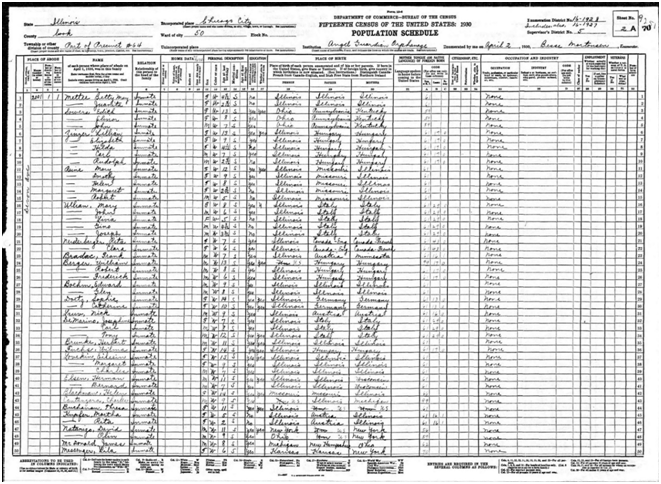
Chapter 8. 1929 to 1941: The Missing Years.
“John Ullian and Linda Ferraro: Roots and Legacy www.Ullian.org March 2018”
Summary
It is difficult for us to imagine the impact of the deaths of first Virginia and then Linda on John and the children. We know that it certainly altered the paths their lives were to take.
For this important chapter, the lives of John and Linda’s children must be related primarily by the recollections of two of their sons: Gino and John Anthony. Gino has written of his life during this time period
[Appendices B and C] and discussed it with his children and his niece Linda Wysocki. The recollections of John Anthony (referred to here as son John or John A., though "in real life" he was called Johnny when young, John later) are from various discussions he and his wife Mildred Maxine (Huffington) Ullian have had with their son John Anthony Ullian Jr. over the years. We recognize that the five children who survived infancy all had different experiences growing up, even while in the same institution (partly due to their separation by age and gender), and that even people with the same experiences can react to them differently. And we all remember (and forget) things differently. Thus we are offering these memories as examples, not the complete description, of the children’s lives during this period – and we do not expect all memories to be accurate.We do not have helpful documentary evidence regarding the lives of John and the children between the death of Linda and the entry of the children into Angel Guardian Orphanage. John A. thought that "Aunt Annie"
[Anna (Comperini) Ferraro, wife of John Ferraro, and thus Linda (Ferraro) Ullian’s sister-in-law] probably took care of the children after their mother died, either before or immediately after the Angel Guardian Orphanage. The kids thought a lot of her. Aunt Annie had a daughter who taught school in Honolulu, but John A. never met the daughter. John A. thought that the Ferraros were probably involved in getting the children into Angel Guardian, a Catholic institution on the north side of Chicago – perhaps through Linda’s brother Gino Ferraro, who was soon to be ordained a Roman Catholic priest.Angel Guardian Orphanage - Chicago IL
Angel Guardian Orphanage was in the Rogers Park neighborhood on the north side of Chicago. It was established as a Catholic orphanage in 1865 for German families and became one of the largest orphanages in Chicago. In the 1930s, during the Great Depression, there were as many as 1,200 children there at a time. By 1974 residential child care ended and it became (and remains) Misericordia, a Catholic charity. There is (in 2018) an "Angel Guardian Orphanage Alumni Website" at www.angelguardianorphanage.com where more information can be found.
The 1930 Federal Census lists (as of 2 Apr 1930) John and Linda’s 5 children as "inmates" at Angel Guardian Orphanage, 2001 Devon Ave., Chicago, Cook, Illinois: Mary 8 years old, John 6, Livia 5, Gino 4 years and 3 months, and Joseph 3 years and 2 months. We do not know when the children entered the orphanage, other than that it occurred sometime during the year between their mother’s death in April 1929 and the Census enumeration in April 1930.

Ullian Children at Angel Guardian Orphanage on 2 Apr 1930 - 1930 Federal Census
John Anthony Ullian’s Memories about Angel Guardian Orphanage
The photo (below) of "Grandpa and his kids" is dated September 1929, 5 months after Linda’s death. John A. believed it was taken when John took his children to Angel Guardian Orphanage, or perhaps during an early visit with them there.
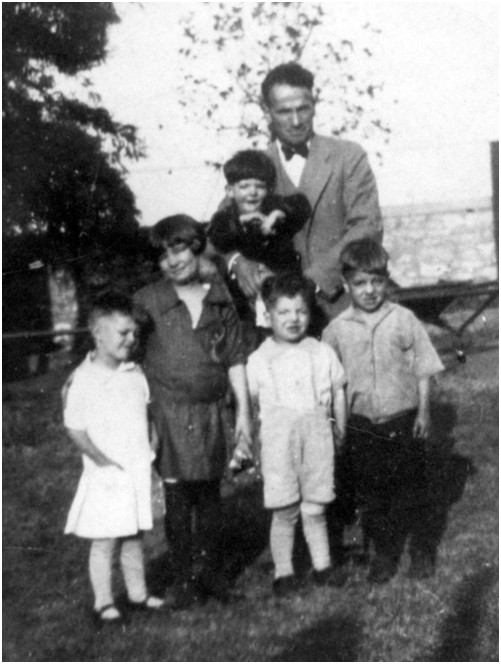
John Holding Joseph; Livia, Mary, Gino, and John A. - September 1929
Son John also remembered his father putting the kids up on lion statues, possibly near the entrance to the Art Institute of Chicago on Michigan Ave., to take a photo of them, possibly while visiting at the Orphanage, but we do not have that photo.
On 24 Oct 2005 John A. and his son John A. Jr. visited the site of the Angel Guardian Orphanage, now Misericordia. It was the first time John A. had seen it since leaving almost 75 years earlier, despite living within 60 miles almost all of those years. Nevertheless, its previous impact on him was obvious from his recollection of many details of the brief time he spent there as a 6 or 7-year-old boy. Some details of that 2005 visit are reported here by his son John A. Ullian Jr.
"The corridors have terrazzo floors. My father remembered them, and that the children never had to clean them. The terrazzo floors in the long hallways looked to me like a great place for a kid to run, but my father said that ‘We didn’t do much running – the nuns were always right on your tail.’ He remembered living on the second floor, above what is now a restaurant open to the public – the Greenhouse Inn. That second-floor space is now used for what appear to be large open classrooms. The partial third floor appears to be an attic and has dormer windows. He recalled one time that their father had written him and his siblings a note telling them when he would be coming for a visit. Before our own visit to Angel Guardian, my father had told me about watching through the windows on the floor above where he lived for his father to arrive, walking from the train tracks. He (and perhaps his brother Gino – he wasn’t certain) saw their father walking from the train tracks, carrying a bag over his shoulder. My father remembered that he brought them a fruitcake. He said that his father told him that there wasn’t a train stop right by the Orphanage, so he jumped off the train."
What is now called the Union Pacific North Line, a component of the METRA system of commuter transportation in the Chicago region, still runs east of the Angel Guardian Orphanage grounds, along Ravenswood Ave. It was originally the Chicago and North Western before that line was bought by Union Pacific. It runs through the northern suburbs of Chicago (e.g., Evanston, Winnetka, Glencoe, Highland Park) where the Ullian and Ferraro families had lived and worked. The Rogers Park Station is about 1.2 miles north of Angel Guardian, and the Ravenswood Station 2.9 miles south.
"The dormer windows of which my father spoke did face east from the easternmost wing of the building, toward the direction of the closest tracks. On the visit, we could see from the ground level near the restaurant (which was 2 floors directly below the dormer window my father watched through) a track-cleaning car moving along the tracks."
"My father said that the kids always wore ‘labels’ so the nuns could take them back to where they belonged if they got lost. Some former Orphanage residents now have internet sites, and one person mentioned that, at least beginning in the 1950s, the children were assigned numbers connected to the ‘cottages’ they were in – so a child might be number 12-11 (child 11 in cottage 12) – my father remembers that when he was there, the label had the child’s name, not number, with a number for the area the child was assigned to."
"We ate at the restaurant, bought baked goods at the bakery counter next to it, and walked throughout the building, except for a residential area and other areas in use at the time. Nothing in the large gift shop mentioned the Orphanage, and there seemed to be almost nothing on the grounds mentioning that former use. The only exception was at a church at the corner of the property, across what is now a large parking lot. The cornerstone indicated that it was St. Henry’s Church, 1905. It had a chapel with a cornerstone reading ‘Angel Guardian Home 1929’ and a bas-relief sculpture of a guardian angel and two small children. There was a blue sign nearer the street noting that it is the Angel Guardian Church. My father remembered the children all walking outside to go to a church, and this was undoubtedly it. I assume that the chapel was built as the population of the Orphanage increased, in order to give the children and adults separate worship areas." When a mission parish for Croatian-speaking Catholics outgrew its own church, it was given the use of this church, which in 1982 was renamed the Angel Guardian Croatian Catholic Mission. It was again renamed in 1998 as the Blessed Aloysius Stepinac Croatian Catholic Mission.
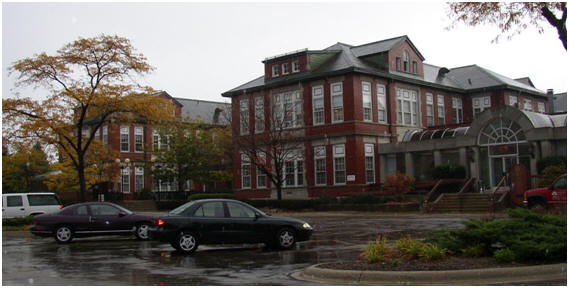
Misericordia
[Formerly Angel Guardian Orphanage] – October 2005
After perhaps a year, maybe more, the Ullian children had to leave Angel Guardian Orphanage. There are conflicting stories about the reason. One story is that the cost was too high. Another story, more accepted in the family, is that the children’s father had a run-in with a nun there about how one of his children was disciplined. Gino’s memory is that his father slapped a nun (or was even more forceful) for washing Joe’s mouth out with soap after he said "darn." John A. does not remember anything like that happening.
Potential support for the idea that the children left the Orphanage because their father could not pay, however, is a piece of information found at http://www.angelguardianorphanage.com/AGORecords.html (viewed on 14 Jan 2018). That site lists items that might be in a child’s folder, including "Payments made to the Home for your stay, either from Social Security, etc." We recognize that the existence of these payments does not mean that children would have been removed if payments were not made.
A document from the Illinois Soldiers’ and Sailors’ Children’s Home (where the children would later live), dated 1 Sep 1944, indicated that "The children had been placed in various orphanages after the death of Mrs. Ullian April, 1929. Mr. Ullian could not maintain the home and had difficulty keeping housekeepers. He could not afford to pay for the children’s care at the Guardian Angel orphanage in Joliet. He applied for admission to Illinois Soldiers’ and Sailors’ Children’s School for three boys, Mary, and Livia." We are unaware of any orphanages the children had been at prior to ISSCS other than Angel Guardian in Chicago. The information in this document may only be the story John told officials at ISSCS. The statement in the ISSCS document says that their father "applied for admission" to ISSCS seems to conflict with the children being placed there by court order [see Appendix G]. The document at ISSCS appears to tell the version of the story that John probably was more comfortable telling.
Gino Ullian’s Memories about Angel Guardian Orphanage
[Note: Most of this section was taken from Gino’s Memoirs in Appendix B, which contains further information about his experience at this institution.]
"I was taken to the Angel Guardian Home with my two brothers, John and Joe, and my two sisters, Mary and Livia."
"This home consisted of four buildings which housed the children. Each had an upstairs and a downstairs. The last building in the row was the church which we visited quite a bit being this was a Catholic School. The long building which was straight ahead and to the left was the school. It was made up of school rooms on the main floor. Downstairs was a commissary where we could purchase candy if we had a few pennies. As we went down the steps to get candy on our immediate left was a heavily wired screened-in room which housed all the rags and a very big police dog. He sure scared us half to death since we were so small. I imagine I was in Kindergarten."
[Gino was born on 17 Aug 1925, and was about 4 years and eight months old when the children at the Orphanage were enumerated on 2 Apr 1930 for the Census.]"At recess time we could go outside and play. It was also the time to go to the bathroom which was the only one we had and was shared by boys and girls. One time I didn’t make it because of the runs and I sure took a whipping for dirtying my pants."
"All around the trees were benches nailed to the trees to make a circle around them for us to sit on. My brother John and I were watching the team practice baseball one day when a player hit a line drive right into my stomach. I cried pretty hard while Johnny rubbed my stomach and tried to soothe me at the same time."
"One thing I remember about our school classes was a break in the morning and one in the afternoon when we were given a thin slice of Baby Ruth candy. Sometimes I swore the inside of the candy bars moved while they were being sliced but they sure were good tasting."
"Each night before we went to bed we had to show the sister (nun) our hands, the backs of them, our elbows, our knees, our heels, and then our ears. If any were dirty, we got a hair brush on the rear and back to the soap. We prayed before and after everything. My father said we were pretty hard to teach since we spoke all Italian and hardly any English. I heard through life the reason we left the Orphanage was by special request. My brother Joe said "darn" to one of the nuns and was made to eat soap. My father, hearing of this used some brute force on her which caused her to enter a hospital for a month or two and us out on our ears."
After the Angel Guardian Orphanage
On 17 May 1930, the Federal Census shows that John was no longer at 692 Central in Highland Park IL. The 1931 Evanston City Directory shows that John Ullian, gardener, lived at 1810 Dodge Ave., Evanston IL (presumably living there sometime in 1930, since city directory information was typically collected in the year prior to publication). Emilia Marinelle
[Amelia Marinelli], Gino Ullian’s godmother at his recent (27 Jan 1929) baptism was also listed at that address. City directories do not list children, so we do not know whether his children were with him at the Marinelle/Marinelle home at any time – he may have moved there when the children entered the Orphanage, or even after they left it.We do not know exactly when the children entered and left Angel Guardian Orphanage. Nor do we know everywhere they were between their mother’s death and entering the Orphanage, or between leaving the Orphanage and arriving at the Illinois Soldiers’ and Sailors’ Children’s School. We do know from the U.S. Federal Census that they were in the Orphanage on 2 Apr 1930.
We know that the County Court of Lake County Illinois on 21 Nov 1932 ordered the children to be placed in the Lake County Detention Home at 137 N. Jackson St. in Waukegan IL temporarily, then transferred to the Illinois Soldiers’ and Sailors’ Children’s School (ISSCS) in Normal IL. The ISSCS Superintendent was named their guardian. The children were to be cared for, trained, and educated by the guardian at ISSCS until the boys were 21 years old, and the girls 18.
[See the court order in Appendix G.] The reason for the order was that "the father as the sole living parent is unable to provide for them, nor are there any living relatives able to provide for them." And we do know that the children were admitted to ISSCS on 16 Jan 1933.In the court order John was said to be living at 581 Laurel Ave., Highland Park – which is in Lake County. That was the address of the home of John’s brother Romano, whose wife Theresa had died in August 1929, just 4 months after John’s wife had died. If John had been living on Dodge Ave. in Evanston (where he was listed in the 1931 Evanston City Directory) at the time of the court hearing, the Cook County court would have had jurisdiction.
Gino wrote of one incident that occurred while he and his siblings were between the Orphanage and ISSCS. "We were moved to a house in Evanston in the dead of winter. I had to walk to school, I think about four blocks. The first day the lady took me to school after giving me a new pair of boots. The next day I made it to school alright but coming home I ran into a small black
and white bull dog. The louder he barked the more scared I got. I ended up running home and losing one boot. When I got home with only one boot, I caught the dickens. While still sobbing, she took me by the hand and went back and found the boot. It must have been 1930 or 1931 so clothes were hard to come by. Being in the depression wasn’t too good anyway. My dad lost everything he had, which I understand was quite a bit being a landscaping contractor. Next, we were to go to Normal, Illinois to the Soldiers’ and Sailors’ Children’s School. I had the whooping cough pretty bad so we couldn’t leave right away. I remember the doctor coming to the house and putting a big black and red sign on our door reading "QUARANTINE – WHOOPING COUGH." We stayed there through Christmas. I remember my father bringing two large bags on his shoulders. One was full of toys and the other clothes. We had a great Christmas, but I was still sick."
Let’s look at some of the details of Gino’s story to examine whether it adds evidence to our understanding that the children entered the Detention Home in November 1932, after the court order, and left it to go to ISSCS in January 1933.
(1) "We were moved to a house in Evanston in the dead of winter." The Lake County Court ordered them to the Detention Home in Waukegan on 21 Nov 1932. They must have been in Waukegan, not Evanston. If it had been Evanston, the Cook County Court would have had jurisdiction. But Gino remembered correctly that it was winter.
(2) "I had to walk to school, I think about four blocks." A "National School Record System Transfer Card" for each of the children who had been in school was completed prior to their beginning at ISSCS. The "date of discharge" from the previous school was 13 Jan 1933. Their address before discharge was 137 N. Jackson St., Waukegan IL
[the address of the Lake County Detention Home] and they had attended West School. That school was at 1319 Washington, about 1 long block and 2 short blocks from the Detention Home, closely matching Gino’s recollection of the distance.(3) "The first day the lady took me to school …." Gino’s use of the term "the lady" suggests that she was not a relative or his godmother
[Amelia Marinelli] – he probably would have named her if she had been a relative r his godmother, or indicated the relationship. The head of the Detention Home was the matron – a woman – probably "the lady."(4) "It must have been 1930 or 1931 …." Close - they were undoubtedly at the Detention Home from November or December 1932 to January 1933, given the date of the court order and the date of their admission to ISSCS.
(5) "We stayed there through Christmas." That fits the November to January timeline.
(6) "I remember my father bringing two large bags on his shoulders." This may suggest that their father was not living with them at the time but coming to see them from elsewhere ("bringing" rather than "coming home with").
Summarizing the "whereabouts" of John and his children from the date of their mother’s death in April 1929 until the children entered ISSCS in January 1933, we know the following:
(1) John and his family lived at 692 Central Ave., Highland Park, at the time of Linda’s death on 13 Apr 1929. A city directory published in 1931 shows that John lived (in 1930, we presume) in the home of Emilia Marinelle, Gino’s godmother, and a widow, at 1810 Dodge Ave., Evanston. At the time of the court hearing in November 1932 he was said to live at 581 Laurel Ave., Highland Park – the home of his brother Romano.
(2) The children entered Angel Guardian Orphanage sometime in the year between their mother’s death on 13 Apr 1929 and the census enumeration on 2 Apr 1930. At some point after that they left the Orphanage. On or shortly after 21 Nov 1932 they were sent to the Lake County Detention Center where they stayed until January 1933, when they entered ISSCS.
Illinois Soldiers’ and Sailors’ Children’s School – Normal IL
The Illinois Soldiers’ Orphans’ Home opened in 1869, and despite a change of name in 1931 to the Illinois Soldiers’ and Sailors’ Children’s School (ISSCS), throughout its existence it was widely known locally, and to John’s 5 children, as The Home. We will often refer to it either as The Home or ISSCS. Normal is adjacent to the larger city of Bloomington in McLean County, Illinois.
We recommend a book by Ruth A. Cobb on the history of ISSCS to those who want more information on this institution. It was published by the Illinois Soldiers’ & Sailors’ Children’s School Historical Preservation Society and printed by University Marketing & Communications, Illinois State University, Normal, Illinois. Copyright 2007, ISSCS Historical Preservation Society.
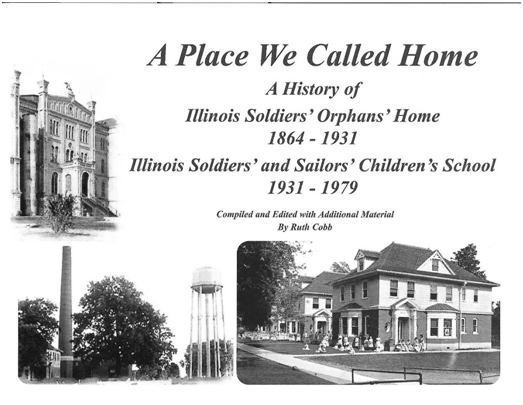
Book Cover
More information about ISSCS, including the memories of a number of alumni, is available on a variety of internet sites. The chapters in our book on John Ullian that are relevant to ISSCS focus on his children’s memories of their experiences at The Home, and not a more objective description and history of that institution. See the Cobb book and other websites for the latter.
The children were admitted to ISSCS on 16 Jan 1933, according to ISSCS records. Brothers Gino and John A. have shared their memories of their arrival day: Gino in his writings, John A. in discussion with his son John A. Jr.
John A. remembered that "When we left the Angel Guardian
[actually, we assume, the Lake County Detention Home] he had a big car – I’m quite sure it was a Packard. It had shades in the back and we all tried to peek around to see where we were going, but we didn’t know where we were going. And then he dropped us off at The Home there. The car was parked right by the circle. We all stood by the Administration Building while somebody came and got us. And then he went in his car. It was real nice weather – I don’t remember us wearing coats." All 5 children went there at the same time. John A. remembered Mary slapping him when he said something - he never did ask her why.Gino wrote "We later drove to The Home in a long touring car which had shades and tassels on the windows and a whole lot of room in it. Upon arriving at The Home we were put in a screened-in large room with radiators that had steam coming out of them. It scared me since I had never seen steam before. This also was the "quarantine cottage" for all new people entering The Home. The first day we got there they gave us some hard Christmas candy and an orange. I cried a long time having to leave my dad and never knowing when I would see him again."
John A. has said that Joe was not old enough to stay at The Home when the children were taken there – he had to stay at the Baby Fold in Normal until he was old enough for The Home. On that date, Joe would have been a little over 6 years old. We do not know how old he would have had to be to enter ISSCS immediately.
Gino’s description of his early days at The Home continued: "The first night as I was looking out the window, I saw a boy come out on the sidewalk with a bugle in his hand. He started blowing it which I later learned was ‘Taps.’ All children had to be in their cottage by Taps or suffer the consequences. I stayed awake most of the night falling asleep in the morning hours only to wake up to the bugle again, blowing ‘Reveille.’ We were located across the street from the Junior High Cottage which was located in the basement of the Administration Building. Below us, as we were located in the second story across the hall from the hospital, was the barber shop. In the years ahead this barbershop furnished me all the cigarette butts that Mr. and Mrs. Crosby, the red-headed barbers, would throw away."
"We stayed in the Quarantine cottage for three weeks to be sure we weren’t coming down with any sickness. The boy who cleaned our room used to sing the same song every day. This was the first song I recall hearing. The first few lines were ‘The Judge said stand up boys and dry up your tears, you’re sentenced to Nashville for twenty-one years.’ I tried to get the words in my adult years but couldn’t find them
." [Linda Wysocki found that the name of the song is "Twenty One Years" written in 1930 in the USA by Bob Miller]"We later were transferred to the little boy’s cottage. It was a building which came out of a fairy book. The building was a white brick cottage with tiled roof. Each window had shutters with an animal cut out in the shape of a rabbit, squirrel, duck or what have you. The inside was a large room with a fireplace that had a Mother Goose theme above it such as Mother Goose, The Three Bears, etc. depending which cottage you were in. We had thirty boys to the cottage, thirty small beds, thirty chairs around small tables and inside plumbing which had the stools built low for our size. There were eight cottages in the village. Miss Polly was our house mother. Discipline was the name of the game. Each boy did his share and toed the mark or else. Or else included a rash of punishments. All of us dressed alike so we didn’t have too much trouble getting dressed. We would walk to school, about eight blocks, lined up in rows of two and not saying a word knowing if you did you would suffer later."
[See Appendices B and C for many stories of Gino’s experiences at The Home.]
Meshing the memories of Gino, John A., and the latter’s wife Mildred tells us the following about ISSCS. The cottages were 2-story buildings, with full basements where the kids played, a ground floor living area, and a second floor with bedrooms. Each cottage had a house mother and a house father. The house parents stayed with the cottage - they didn’t move with the kids as they progressed. The house parents received room and board, and a very low salary. The children were divided by sex and age among the cottages. The cottages for the younger children had
child-size toilets, and the long table they ate at was at the right height for them. The cottage shutters had animal silhouette cut-outs. The older children’s cottages had hardwood floors that they had to shine every weekend. The sleeping quarters were like Army barracks - bunk beds along the walls, and big windows with draperies that the house parents could open to check on the kids, but the kids couldn’t check on the house parents!
The kids didn’t have desks – they did their homework in their beds. There was a study hour in which they could get most of their homework done. Food was cooked elsewhere and brought to the cottages, not cooked in the cottages, but the dishes were washed in the cottages. State dietitians had to approve the meals. Two boys would take the laundry down in wagons and bring back ice – the kids were waiting for the ice when they returned.
Each cottage was sponsored by a different American Legion Post, which provided the kids with "extras." An annual "Legion Day" brought to The Home Legionnaires who sponsored the cottages from throughout the state. It was a popular and fun holiday for the kids and the Legionnaires. Gino has written of one of his successful methods of separating the Legionnaires from their coins in Appendix B.
There were movies at their own movie theater every Friday night (including
Gone with the Wind, John A. remembered), their own big swimming pool, a hospital/infirmary, and a dentist. The grade school and junior high (Felmley Junior High School – which ended at eighth grade) were at ISSCS, and the children went to high school at University High on the grounds of what was then called Illinois State Normal University – which Mildred believes had only 3 buildings at that time. The high schoolers had their lunch in large private homes near University High under contract with ISSCS, and the food was brought there every morning by ISSCS.John A. remembered, corroborated by Gino’s writings, that his father occasionally sent letters for the children with checks to "Big Bill" of Big Bill's Cabins in Normal, across the street from a gas station near The Home. Gino remembered Big Bill as "a huge man who was crippled." Big Bill cashed the checks and John A. shared the money with his siblings. If the checks had been sent to the children through ISSCS, the children would have been limited in the amount they could withdraw and what they could use it for – withdrawals from their personal accounts needed permission. John A. had a vague memory that the checks were sent from a "Eureka Bank" which he thought was probably in Texas, but we have no way to corroborate that. Sometimes the checks were cashed at the nearby "Fanny Bright's Farmstand" – where locally-grown strawberries and other produce were sold in season.
John A. and his wife Mildred both knew Big Bill later in life. His cabins, which no longer exist, were about 4 blocks from the small house at 406 E. Poplar St. in which Mildred and her 8 siblings grew up. The cabins were right by the Royal Crown Cola plant, a block west of Forbes’ grocery store, and 2 blocks west of Tom Manning’s store
[which Gino mentioned in Appendix B]. Mildred remembers Tom Manning’s store as including a small store, a café, maybe 2 gas pumps, with some cabins across the street. There were rumors in Normal that Tom Manning dated country star Minnie Pearl, and that she visited him there. Big Bill’s Cabins, Forbes’ store, and Tom Manning’s store were all on the section of Pine St. in Normal that was part of the original U.S. Route 66. Big Bill had a reputation as a "real nice guy" and it was easy to be friends with him. John A. and Gino remembered that their father became a friend of Bill’s. Gino added that their father stayed at Big Bill’s Cabins when he came to visit.There was a "hobo jungle" by the Chicago & Alton Railroad tracks near ISSCS that some of the kids used to visit. Son John learned how to parch corn there, a skill he used one day when he (temporarily) ran away from The Home. Gino trapped muskrats and sold their carcasses to the hoboes for their meals, and the boys occasionally brought vegetables from the ISSCS kitchen and root cellar to give the hoboes. They enjoyed the hoboes’ stories, which would flow freely as the food was cooked and eaten.
Mildred knew Gino, but she didn’t know John A. when the brothers were at ISSCS. She first visited The Home when a friend invited her to see the little kids in their cottages. But she and her family interacted with a lot of kids from The Home when they passed by her house at 406 E. Poplar in Normal – a few blocks from The Home, and on the route from The Home to downtown Normal. As they passed by her house on their way to the movies, some kids asked Mildred’s mother, Edith Huffington, for a penny for candy at the movies, and she often provided those pennies. Edith was also an easy touch for the hungry hoboes looking for a sandwich – and it was rumored that they had marked her home as a good place to ask for food.
Gino and John A. have different memories about the children’s regular spending money. John’s memory was that the kids at The Home received 10 cents a week for themselves, and a popular way for the kids to spend that dime was to go to the movies in downtown Normal, which cost a dime (before the war tax was initiated). That didn’t leave any money for candy unless they got it elsewhere, and Edith Huffington’s pennies were a frequent source. John A. and Mildred believed that the dime came from the local American Legion Post. Gino has provided a more detailed account, indicating that The Home kept an account for each child for money sent them by their parents, and every Saturday the child could check out 10 cents, reporting how it would be spent. "If they didn’t like how you wanted to spend the money, you wouldn’t get any." Gino’s recollection was that a ticket to the movies cost 11 cents – whether he meant the price before or after the war tax we do not know – requiring that the kids find the extra penny elsewhere for the film alone – without candy.
Gino wrote that for Christmas the kids could mark 3 things they wanted in the Sears catalog that cost $1.50 or less.
[We are uncertain whether this meant 3 items that together cost $1.50 or less, 3 items that each cost $1.50 or less, or possibly 3 items from which 1 that cost $1.50 or less would be chosen for them.] The catalog was passed through the kids in alphabetical order – and the Ullian kids would receive a pretty worn catalog. When Christmas came, a Santa from the American Legion Post sponsoring a cottage brought the gifts for the kids in that cottage. Whether the funding for the presents came from the state or the American Legion was an area of disagreement between Gino and John A.
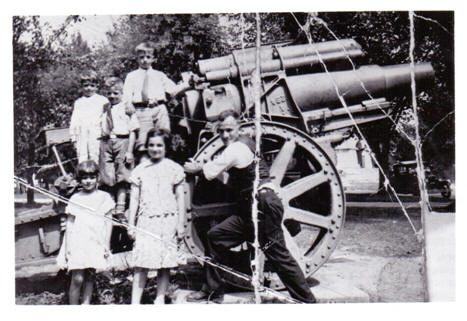
Joe, Gino, John A., Livia, and Mary with father John Ullian.
Probably in Miller Park, Bloomington IL
Mary and Livia at ISSCS
Most of the information we have on the lives of John’s daughters at ISSCS is from their initial and subsequent evaluations (medical, psychological, and educational) at ISSCS. Below are excerpts from those reports as well as additional information we have on Mary’s and Livia’s experiences at The Home as well as shortly afterward. They left ISSCS before their brothers did. Mary and Livia were discharged from ISSCS on 7 Aug 1937 and traveled by Greyhound Bus to a foster home in Joliet IL. Mary was 15 years and 9 months old, and Livia was 13 years old.
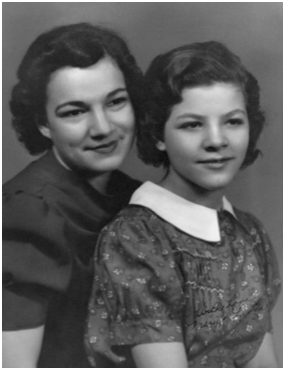
Mary and Livia Ullian
Mary
was a "pleasant rather serious girl who became more at ease and spoke more spontaneously about herself toward the end of the examination. She was fairly alert in comprehending directions, and was careful in her responses to them. She became embarrassed when she could not respond to a request, and appeared to have some difficulty in expressing herself as clearly as she wanted to. Cooperation and effort were good thruout."Mary was 11 years old (the oldest child in the family) when she entered ISSCS and was 55 ¼ inches tall, weighing 90 ¼ pounds. She had measles at age 8, mumps at age 10 and a few colds. She had her tonsils removed previously. Her vision and hearing were good. She was admitted to the hospital for one day in July 1934 for a pain in the side of her neck and for 3 days in 1935 for German measles.
Mary had been in fifth grade prior to her entrance, and the assessment was that she would be able to the work at the fifth-grade level, and she was placed there. She was promoted to sixth grade on 6 Jun 1933, to seventh grade on 7 Jun 1934, and graduated grade school in June 1936. She was a good student achieving mostly average to above average grades. Mary entered University High School (on the Illinois State Normal University grounds) as a freshman for the 1936-37 school year and finished the year there. She was discharged from ISSCS in 1937 and sent to live with a foster family, the Linds, at 408 Kraker Ave. in Joliet IL while attending Joliet Township High School until graduating in 1940. The 1940 Joliet City Directory shows Mary and "Olivia" Ullian living together at 408 Kraker Ave., Joliet.
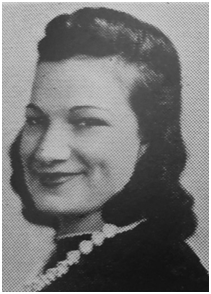

Mary Ullian in 1940 Joliet Township High School Yearbook
While in high school, Mary has said, she would spend the nickel given to her for the church collection plate on candy, which she would sit on the railroad track and eat. After graduating from high school in 1940, Mary worked at Will County Cleaners in Joliet.
In 1939 she met her future husband, who lived a half block away from her foster family – she would ride her bicycle around the corner to see him. Mary married David Robert Larson Jr., on 3 May 1941 at Trinity United Methodist Church in Joliet. They moved to 116 Briggs St. in Joliet.
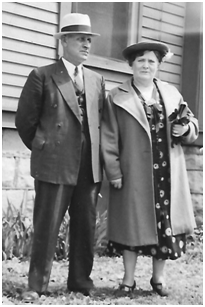
Mary and Livia’s Foster Parents: Mr. and Mrs. Lind
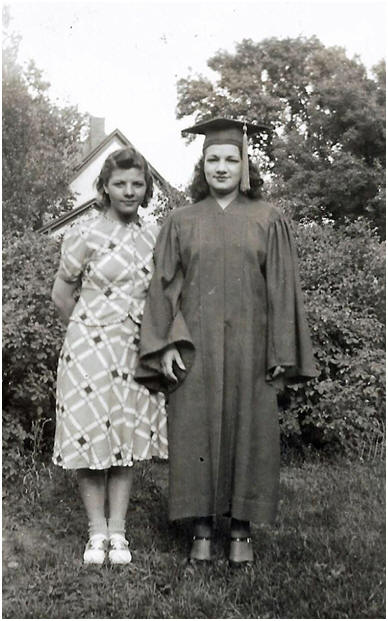
Livia and Mary Ullian at Mary’s Graduation - 1940
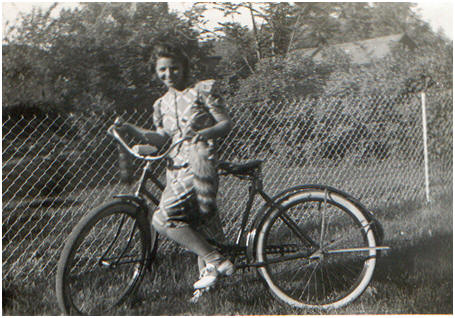
Livia on her Bike
[Notice the fox tails on the handle bars!]
Livia was "a friendly girl with a bright smile and interested manner… She listened attentively and cooperated with good effort." She was placed in second grade upon entrance to ISSCS. Livia had chicken-pox, headaches and a few colds, and had her tonsils removed. She had good vision and hearing when she was admitted to ISSCS in 1933. She was then 8 years old and 46 ½ inches tall. Livia was in the hospital quite often in her 3 years at ISSCS. She had upper respiratory infections and influenza several times in that time span. The most serious illness that Livia had was German measles, for which she was hospitalized from 10 to 14 Dec 1934. By the 1936-37 school year, Livia had completed fifth grade.
With her sister Mary, Livia was discharged from ISSCS in 1937 and sent to live with the Lind family in Joliet. Livia later moved to the home of the Lind’s daughter, Dorothy Nordstrom. We believe that Livia attended St. Patrick’s Catholic Grade School for sixth through eighth grade. In 1940, Livia was placed in the home of sisters Gert and Ella Nealis who lived on Pleasant Street in Joliet. She spent summers with the Nealis sisters and went to a Catholic boarding school, Mount St. Mary’s on the Fox River in St. Charles IL, for high school. She completed three years of high school.
Livia had found a surrogate mother in her house mother at ISSCS: "Ma [Augusta] Becker." Livia kept in contact with her throughout her life. Ma Becker lived to be 99 years old. Currently (2018) Livia doesn’t have many memories of The Home, except that she didn’t have any contact with her siblings. She grew up hating tapioca pudding because she always had to eat it at The Home and would never eat it the rest of her life. She said that her father didn’t visit them often. It was her opinion that he was having a good time in Texas, drinking and gambling. Of course, we will never know whether that was the case.
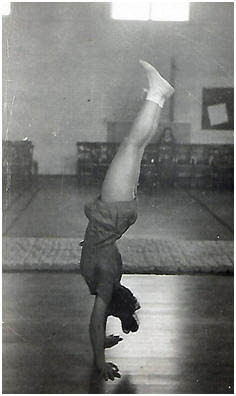
Livia Doing Handstand
[Probably at Mount St. Mary’s]
John A., Gino, and Joseph at ISSCS
We have much more information on the experiences of the Ullian boys at ISSCS – primarily due to Gino’s writings and discussions John A. Ullian Jr. had over the years with his parents, but also because the boys were at ISSCS longer.
John A. was almost 10 when he went to The Home, and about 18 or 19 when he left. He always had fond memories of ISSCS later in life, as did his wife, Mildred. Mildred had been a "local girl" who lived a few blocks away and visited The Home with friends occasionally. John A. has said that they took good care of the children at The Home. The kids had all the basics during the years of the Great Depression, when many kids outside did not. Mildred remembers that the kids at ISSCS were better off than kids she knew in a couple of foster homes at the time: "They had all they needed, except that they didn’t have their parents."
John A. had his tonsils removed at the hospital/infirmary at The Home. Joe stole ice cream from the kitchen for him – Joe was skinny and could fit through the transom window. When they had their tonsils out, they needed something cold for their throat during the night. They would take 3 gallons of ice cream at a time and pass them through the transom. John A. has said that the ice
cream was the only thing they stole from The Home. He said that they could get away with it because no one thought that using the transom as the kitchen entry/exit point was possible.
John A. liked to work (voluntarily) at the bakery at The Home. He went there in his free time, and one of the bakers would sometimes give him a few cents or a nickel spending money for his help. Gino also helped out in the bakery, washing pots and pans for pennies.
One of the people John A. remembered fondly was Mrs. Goggins. She and her husband were house parents at Chateau Thierry
[the cottages had World War I themes] when John A. lived there. That was the cottage for senior boys, and John A.’s last cottage. Mrs. Goggins was young, about 3 years older than the boys in her cottage. She slept in the Administration Building, away from the boys, due to their age proximity. Her husband worked 8 hours a day for the railroad in addition to being a house parent.Some of the children, especially when older, developed their own ways of making money at ISSCS. Gino has written
[Appendix B] about a number of different adventures he and his friends were involved in to raise a little money. The most profitable was a traditional summer job for youngsters in rural areas in those days: de-tasseling corn. His memoirs state that he graduated (from eighth grade at Felmley Junior High) in 1938; he actually graduated in 1939 – his brother John graduated in 1938. Gino de-tasseled corn for the Funk Seed Company the summer before his graduation, working every hour he could, leaving for work at 4 a.m. He made $28 that summer, more than any other child at The Home, he believed. After graduation, he was moved to Pershing cottage, where the children were allowed to raise chickens and pigeons and sell them for a profit. He and a friend built their own chicken coops, got culls (baby chicks not wanted by the local hatchery), raised, killed, and dressed them, and sold them for 10 cents per pound. They got some of the feed for the chickens by picking and shelling corn at a local farm, where they received some of the corn for the chickens. He and several friends hunted rabbits (using a rock to the head after catching them to dispatch them), sometimes catching 25 in a day. They dressed them and sold them "to adults" for 25 cents each. They trapped and skinned muskrats and stretched the skins and dried them in their attic. They took the carcasses to the hobo jungle and sold them to the hoboes for a dime each to make stew. They also brought vegetables from The Home’s root cellar to the hoboes and sat around listening to their stories.

Eighth Grade Graduation, ISSCS. John A. Ullian is fifth from right in bottom row.
In 1938, John A. graduated from eighth grade at Felmley Junior High School at ISSCS. The close-up (below) of his graduation picture shows him in the bottom row, fifth from the right, wearing white shoes. Gino has reported that the boys’ suits came from a collection at ISSCS – worn only at graduation, then returned for next year’s graduates.
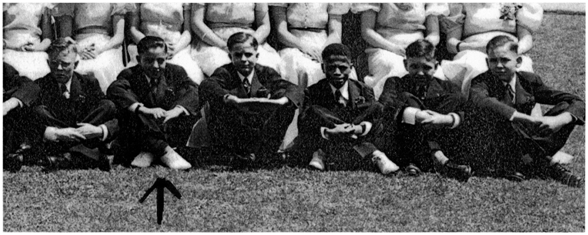
Closeup of the Graduation Photo. John A. is fifth from the right
John A. was on the wrestling team at University High – he wrestled at 137 pounds and later weighed 145 pounds as a 20 year old in April 1943 when he entered the Army. Gino also wrestled for U High, in the lightest weight class. Gino has written that he didn’t think he won a match in 2 years, but he made a lot of friends.
John A., Gino, and Joe all played in The Home’s Drum and Bugle Corps. According to Gino "We had one of the best outfits in the State. We were called on to play all over the State in parades and at fairs and just to play for the people. We had eight snare drums. I had one on the right pivot and my brother John had the left pivot. Brother Joe clanged the symbols
[cymbals] with another guy and we had two bass drums with our school name on them. … We were decked out in a white uniform with a high hat and a tassel on it. … We led the parade at the State Fair every year because we could play the loudest of any band there." [Appendix B]John A. was also a member of the ISSCS Boy Scout Troop 5.
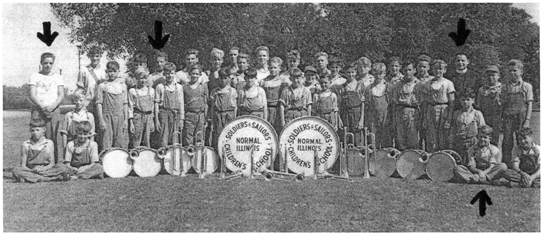
John, Gino, and Joe with the ISSCS Drum and Bugle Corps.
Their uncle Father Gino Ferraro was visiting them that day and is also in the
photo.
The boys welcomed the Cracker Jacks Fr. Gino would bring them when he
visited.
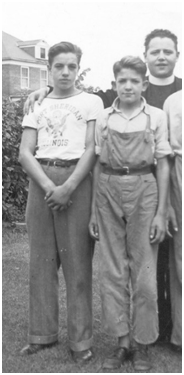
John A. and Joe with Fr. Gino

Pantagraph
[Bloomington
IL] 9 Feb 1939
The following are excerpts from the ISSCS medical, psychological, and educational reports about the Ullian boys.
John
was "an active alert looking boy. He was quite self-assured and cooperated with interest in all that was requested of him. His quick active manner and quick response made him appear more alert than his comprehension of directions and test performance show him to be. He was impulsive and failed to grasp the complete import of directions. He talked readily and spontaneously about himself."John had been in the third grade and was placed in third grade. We don’t have any records for fourth grade, but John was in fifth grade in 1934-35 where he was an above average student. In the 1935-36 school year, John was in the sixth grade, where again he did well. John went to Felmley Junior High School at ISSCS and was in the seventh grade during the 1936-37 school year. He graduated from eighth grade in 1938. He had a good attendance record in school. He went to University High School but left just prior to graduating to live with a foster family in Joliet IL.
Gino
was a "quiet, rather serious boy who enjoyed taking the tests. He smiled widely several times and seemed anxious to do his best. He listened carefully to directions and comprehended them easily. Responses were given at about an average rate. Though he did not talk spontaneously he responded readily to questions. He seemed aware of his failures."Gino had been in grade 2B and he was placed in 2B for the end of the 1932-33 school year. Gino was promoted to 2A in June 1933 and in 1933-34 he did well and was promoted to 3B in June 1934. He was promoted to the fourth grade in June 1935. By June 1939, Gino graduated from Felmley Junior High school. Gino could be a bit of a mischief maker: "Aug. 26 - struck a match in Boys’ toilet during time between classes." Gino then went to University High and was in his senior year in 1942, leaving for the military before graduating.
Joseph
was "an attentive youngster with a serious manner. He was at ease and though he was not spontaneous in talking, he cooperated in a straight forward way. He was quiet but not typically dull in his behavior. He was observing and interested in things about him and listened attentively to directions. Comprehension was fairly good."Joe had a hard time adjusting to school. He was placed in kindergarten upon entrance to ISSCS. He had somewhat of a stammer in his speech, but by June 1940 Joe "adjusted to the schoolroom situation very well. His reading is greatly improved since he does not stammer any more. He has progressed in all subjects."
Joe attended Felmley Junior High School in 1941 and 1942. Joe didn’t graduate from eighth grade at Felmley because he was discharged on 15 Aug 1943
[at about 16 years 7 months old] to a foster home in Joliet. It is believed that his father requested the change so that Joe could work with him in Joliet.Where Was John?
Where was their father? Frustratingly little detail is known about where John was and what he did while his children were in the Angel Guardian Orphanage and The Illinois Soldiers’ and Sailors’ Children’s School. This was the era of the Great Depression, with between 12 and 15 million people unemployed during its depths in the early 1930s. Many of the unemployed, like John, were on the road, working where they could. Obviously much has been written already about this era, so we know that our grandfather’s situation was common in those years. He hardly ever spoke to his children or grandchildren about where he was or what he did, so we have had to piece together what we could from sparse existing documents and the few vague stories remembered by his children.
We have limited information, some of it contradictory, about where John was during these years. John moved often, or at least the addresses he used changed often. We have the following locations attributed to him from the birth of his first child in 1921 until his marriage to his second wife Domenica
[Nina] in 1944.Note that these addresses were "attributed" to him. We cannot say whether he actually lived at all of these locations (especially the homes of relatives, and the street address of an employer) – he may have used them as mailing addresses while he was "on the move" or in temporary housing. These were the Depression years, and the idea of a stable home address as we think of today was no doubt more a dream than a reality for thousands or hundreds of thousands of men.
(1) 4 Nov 1921 – 710 Houghton St., Rockford IL. Home at the birth of daughter Mary.
[Source: Mary’s birth certificate.](2) 16 Apr 1923 – Glencoe IL. Home at birth of son John.
[Source: John’s birth certificate.](3) 21 Jul 1924 – Northbrook IL. Home at birth of daughter Livia.
[Source: Livia’s birth certificate.](4) 17 Aug 1925 – Northbrook IL – Home at birth of son Gino.
[Source: Gino’s birth certificate.](5) 24 Dec 1926 – Northfield Township
[which includes Northbrook] – Home at birth of son Joseph. [Source: Joseph’s birth certificate.](6) 11 Jun 1928 - 344 Madison St., Glencoe IL. Home at birth of daughter Virginia.
[Source: Virginia’s birth certificate.](7) 13 Apr 1929 – 692 Central Ave., Highland Park IL. Home at his wife Linda’s death.
[Source: Linda’s death certificate.](8) 1930 or 1931 – 1810 Dodge Ave., Evanston IL. The home of Emilia/Amelia Marinelle/Marinelli (Gino’s godmother, and a widow), her daughter Lucille, and [at least] John.
[Source: 1931 Evanston City Directory.](9) 21 Nov 1932 – 581 Laurel Ave., Highland Park IL. The home of John’s brother Romano Ullian.
[Source: Lake County Court order.](10) 1936 or 1937 – 401 Jefferson Ave., Glencoe IL. The home of Frank Ferraro.
[Source: 1937 Evanston City Directory.](11) 1938 or 1939 – 401 Jefferson Ave., Glencoe IL. The home of Frank Ferraro.
[Source: 1939 Evanston City Directory.](12) 29 Sep 1939 – 1725 Westheimer, Houston TX.
[Source: John’s application for a Social Security account number.](13) 1939 or 1940 – 501 Anita Ave., Houston TX.
[Source: 1940 Houston City Directory.](14) 9 Feb 1942 – 1103 ½ Franklin Ave., Houston TX.
[Source: John’s duplicate original certificate of naturalization, acknowledging his naturalization on 1920.](15) 27 Apr 1942 – 7616 Eureka, Box 7398, Houston TX. The street address of his employer at the time, N. J. Smith Supply Co.
[Source: John’s draft registration card.](16) 29 Jan 1944 – Joliet IL.
[Source: License for marriage to Mrs. Domenica Salbego.]The specific Houston addresses we have found in our research were unknown to the family previously. But John had spoken at least minimally of Texas. His son John A. recalled some snippets of clues regarding his father’s whereabouts and activities during this period. Texas was a common theme. John talked with his son John A. about how windy it was in Dallas and Fort Worth. When Dallas or Houston were mentioned on the news or weather broadcasts, he would perk up and say "Dallas, you" or "Houston, you" – signifying that those cities were meaningful to him. John’s grandson David U. Larson also remembers his grandfather reacting to mention of Texas cities in this way. When their father did visit his children at Angel Guardian or at The Home he at least once brought them a fruitcake that he called the best fruitcake in the world – which may very well have come from the famed Collin Street Bakery in Corsicana, between Dallas and Houston. He told his John A. that when he was in Texas, he was jumped, beaten up, and his car and everything in it were stolen. (He had also said the same about St. Louis.) He further claimed that he had been working at Gene Autry’s ranch, or at least with Gene Autry’s horses (perhaps in Corsicana, perhaps at the King Ranch – he mentioned both places). He said that Gene Autry personally loaned him money to buy a car after his was stolen. We have no corroboration for these stories. We have, though, uncovered some information regarding Gene Autry and horses he owned in Oklahoma and Texas that may provide for at least the possibility that John had some contact with Autry and/or his horses. We also know that Gene Autry had a radio show on WLS in Chicago while John was living in the area.
We have been able to document several instances of John’s connections to Houston TX and provide some historical context.
John applied for his Social Security card on 29 Sep 1939 in Houston. His employer was Lambert Landscape Co., 2503 Westheimer, Houston TX. A Lambert’s Landscape Co. also existed at the time in Dallas TX. John gave his address as 1725 Westheimer, Houston TX, which would have been less than a mile from his employer. He gave his age as 49, having been born 5 Sep 1890 in Italy.
[Church records and his own earlier statements showed that he was born on the sixth, but he sometimes used the fifth as his birthdate.] He listed his parents as Anthony Ullian and Mary Mascarello.
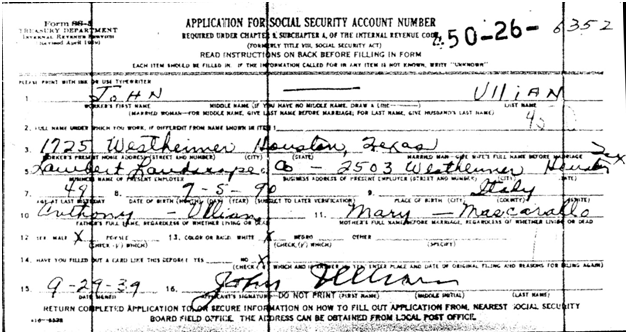
John Ullian’s Application for a Social Security Account Number
The 2503 Westheimer
[Westheimer Road at Kirby Drive] address of Lambert’s Landscape in Houston is now the address of the Forum of Civics Building and Gardens, owned by the River Oaks Garden Club. According to its website (http://www.riveroaksgardenclub.org/site/Forum.cfm), the building was built in 1910 and has been owned by the River Oaks Garden Club since 1942. It is on the National Register of Historic Places. First a county school, the building was remodeled in 1927 to become the headquarters for the Forum of Civics, an organization founded by Will Hogg, chair of the Houston Planning Commission. The Forum was founded for Houston’s betterment and beautification. According to the Garden Club’s website, "One of the Forum's projects was the citywide planting of crepe myrtles, roses, and shade trees, all of which were donated by Will Hogg." Hogg bequeathed the building to the University of Texas, which sold it to the River Oaks Garden Club in 1942. We can logically speculate – without direct evidence – that Lambert Landscape was on the grounds of the Forum of Civics to provide the labor for the Forum’s citywide plantings. Further research into the Forum’s programs at that time might answer that question. We can further speculate that John Ullian was probably one of the gardeners who participated in this citywide beautification of Houston.There was much development occurring in Houston in the 1930s (in contrast to what was occurring then in much of the nation) because of the discovery of oil in Texas in the early 1900s. Oil-money homes were being built in the 1930s in one of the most exclusive areas of Houston, River Oaks, and landscaping the large lots of the River Oaks mansions had to be a booming business. Lambert Landscaping, at Westheimer Rd. and Kirby Dr., was on the southern edge of River Oaks. And this was all within a couple miles of Camp Logan, where John underwent his basic training for the Army in 1917. It is easy to believe that looking for work as a gardener John returned to the city of his basic military training; to a city where gardening is more feasible year.
round than in Illinois; to a city actively building large homes and mansions on large lots that need (and whose owners can afford) extensive landscaping; to a city with a city-wide program for planting trees, shrubs, and flowering plants for beautification; to Houston.
There is no entry for John Ullian in the Houston City Directories for the following years: 1936, 1937-1938, 1939, 1941, 1942, 1943-1944, or 1945. The 1940 Houston City Directory, probably using information collected in 1939, enigmatically includes the following entry: "Ullian (Nina) landscaper r 501 Anita Av." In these directories, a name in parentheses indicates the spouse of person listed. We suspect that the main entry is for John (though his name is not given) and that Nina is Domenica/Nina Salbego (whom John married later, in January 1944). The abbreviation "r" indicates that this is a residence. We can imagine that the canvasser for the city directory did not find anyone home, but a neighbor told the canvasser that Mr. Ullian (whose first name she didn’t know) was a landscaper, and that his wife’s name was Nina.
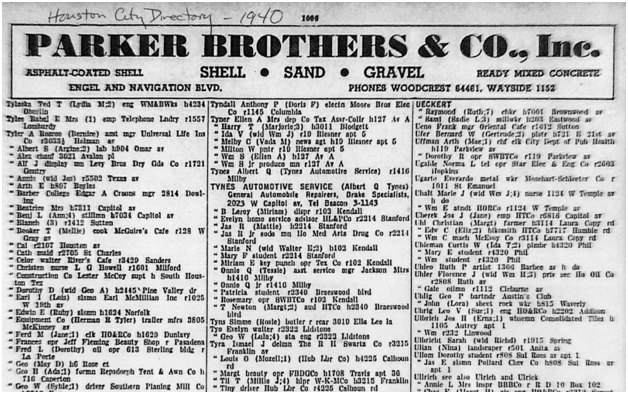
John Ullian and Nina in the 1940 Houston City Directory
Based on what we have discovered in researching John’s life, we can say without a doubt that he worked in Houston at least part of this time. Was he in Houston prior to his September 1939 Social Security application? Possibly. Perhaps he was traveling, working where he could, wherever that was. Perhaps he actually was living with relatives in Illinois prior to moving to Houston. Perhaps he was in Illinois during the "good weather" months there, when landscaping work was available, and moved to Texas to work in its warmer weather in the winter. We do not know.
It is not clear how often John visited his children while they were at ISSCS. By one account, he would come every Christmas with toys, Cracker Jacks, and (as he may have done when they were at Angel Guardian Orphanage) a fruitcake (round, gold label, with "wine" in it) that he said was the best in the world
[from Corsicana TX?]. Late in his own life John A. said that he could specifically remember 3 visits from his father, once accompanied by their uncle (their mother’s brother) Fr. Gino Ferraro. We do know that he did not abandon or forget about his children – as is demonstrated in the next chapter.
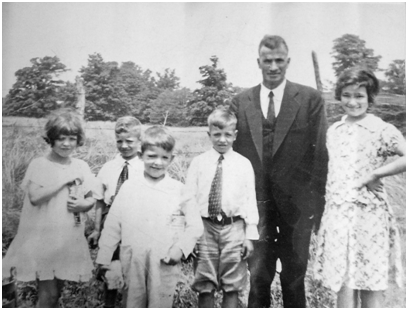
Livia, Gino, Joseph, John A., John, and Mary Ullian.
Other Family Members
During the time frame of this chapter, 1929-1941, John lost his sister-in-law Theresa (wife of Romano) on 12 Aug 1929, and his older brother Romano on 26 Nov 1939. Romano played a large part in John’s life in the United States. He is buried in Memorial Park Cemetery, Skokie IL.
[For more information on Romano and his family see Chapter 13.]John also lost his father-in-law, Frank Ferraro, on 29 Mar 1926 and his mother-in-law, Catherine (Villanova) Ferraro, on 29 Sep 1941. They are both buried in St. James / St. Mary Cemetery in Rockford IL.
[For more information on the Ferraros see Chapters 15 - 17.]